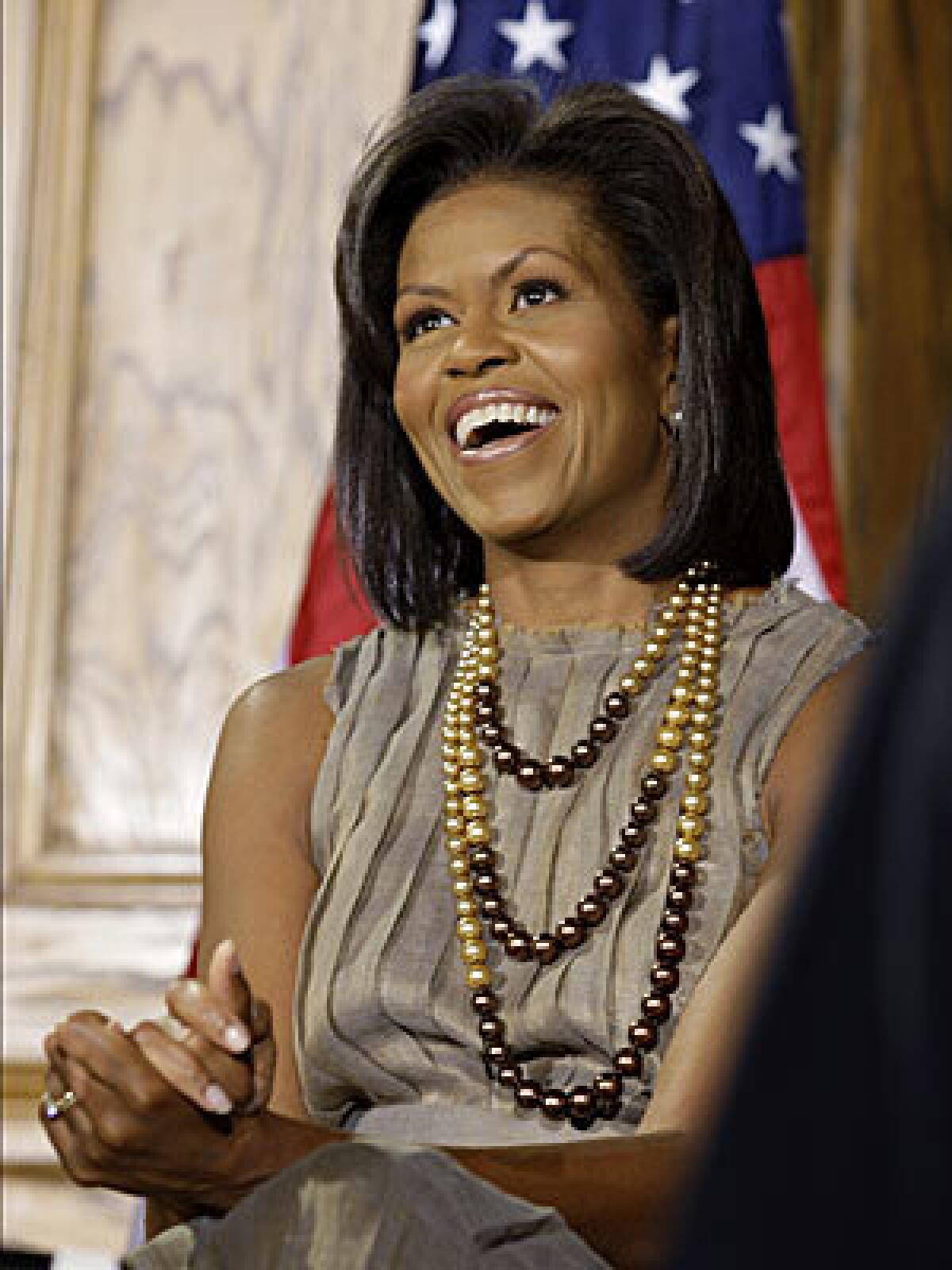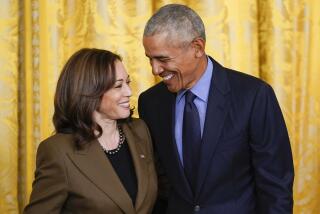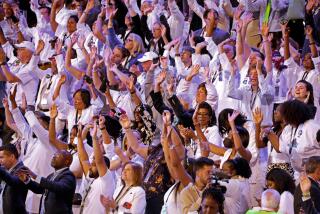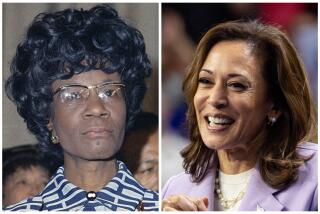Michelle Obama’s real-world style

- Share via
Fashion has a new first lady.
If the black-and-red dress Michelle Obama wore for her husband’s victory speech Tuesday is any indication, she is poised to be her own kind of style icon in the White House. The straight-from-the-spring-runway dress, which she paired with a black cardigan, was a major statement, the patriotic red bursting out of black like a firecracker out of the night sky. You either loved it or hated it, but you couldn’t ignore it.
Obama, 44, proved that unlike many other first ladies, she does not intend to fade into the background. The high-end, intricately embroidered dress that launched a thousand blog posts is by American designer Narciso Rodriguez, who first gained notice for his clothes for the late Carolyn Bessette Kennedy, most notably, her wedding dress.
Similar runway styles cost $3,500 or more, but Obama’s wardrobe is not merely a collection of big names and bigger price tags.
Obama combines youth and beauty with an innate sense of what to wear. She has worn clothes by several American designers on the campaign trail, but she’s mixed them with cheap-chic finds, suggesting she will have a more down-to-earth fashion identity than any recent first lady.
Not only is Obama’s high-low style modern, it’s right for right now. She reflects the American-led democratization of fashion that has revolutionized the way the world dresses by making designer names available in Target and JC Penney. It’s a more sensible approach to spending that’s in tune with the economic times.
“She will be able to have access to designer dresses, but she could also be a role model if she can talk to Middle America about clothes that are not expensive but look great,” says presidential historian Doris Kearns Goodwin, who has written books about Abraham Lincoln, Franklin and Eleanor Roosevelt and Lyndon Johnson, among others.
At the high end, the teal sheath ($795) she wore with a starburst brooch at the Democratic National Convention was designed by Maria Pinto, a Chicago-based designer who sells to Saks Fifth Avenue, among other stores. Pinto told the Chicago Tribune that retail orders for her pieces have increased 45% within the last 12 months and attributes some of that rise to the first-lady-in-waiting. Obama’s rose-print convention dress ($1,250) was by Thakoon Panichgul, a young New York designer who sells to Neiman Marcus and Nordstrom and has a line landing in Target on Christmas Day.
But Obama is a real fashion enthusiast, someone who enjoys the thrill of the hunt for that perfect $30 black-and-white-checked Gap sundress like the one she wore on the Fourth of July.
With retail sales sliding and a difficult holiday season ahead, there is already evidence that Obama could get America shopping again. There’s even a fashion fansite dedicated to Obama at www.mrs-o.org.
“No matter what she does, it’s going to be good for retail because people are focused on her and what she’s wearing,” says David Wolfe, creative director for the Doneger Group, a trend forecasting firm. “And she isn’t so perfect she’s frightening.”
After Obama wore a $148 Donna Ricco sundress on “The View,” White House/Black Market sold 2,500 of the dresses, according to a company spokesperson. She name-checked J. Crew on “ The Tonight Show With Jay Leno,” pointing out that she had bought her $148 Pembridge dot pencil skirt and $89.99 color-block cardigan online. Both styles sold out on the J. Crew site the next day.
“She’s taken the idea of what a first lady should be and turned it on its head,” says J. Crew creative director Jenna Lyons. “Before Michelle Obama, everyone had the idea that you had to be suited up and running with the crowd to be taken seriously. It’s fabulous to see her on the cover of a magazine in a hot pink dress. She’s not afraid to step out in something unusual.”
Unlike France’s first lady, Carla Bruni-Sarkozy, a former fashion model who has made headlines for her fashion sense over the last year and often appears in Dior, Obama is not devoted to one label. She has the confidence of a career woman, someone who’s accomplished on her own without her husband by her side. And as a member of the post-feminist generation, she has the luxury of not having to worry that her interest in clothes will make people take her less seriously.
Goodwin can quickly give a style run-down for various first ladies: “You think about Eleanor Roosevelt who went out sometimes with her hairnet on, and still became the most important first lady in the history of the country,” she says. “Mamie Eisenhower had some sort of pearls, but it’s hard to think of her or Bess Truman as style icons.
” Hillary Clinton told me when Jackie Kennedy was giving her fashion advice, she said not to let designers define you. Let them give you recommendations, and find your own style. Then Hillary deadpanned, ‘But I don’t have my own style.’ ”
That’s not an issue for Obama. The pitches are already pouring in from fashion companies about how to get the “Michelle Obama look” -- the brooches, the pearls, the form-fitting shift dresses. Add a hair flip to Obama’s retro femininity, and it’s no wonder she’s been compared to Jacqueline Kennedy.
But Kennedy’s style was rooted in haute couture. She was a reflection of a time when America still had to prove it could be a cultural center on par with Europe, with all the fine music, art, food and fashion that goes with that. So she impressed the world by speaking French and wearing versions of Givenchy dresses that she worked with American designer Oleg Cassini to replicate.
The famously size-2 Nancy Reagan was roundly criticized for spending too much money on high-end clothes by Los Angeles designer James Galanos and others. Her intricately beaded dresses reflected the opulence of the 1980s but were not anything the rest of us could relate to.
While the world has been transfixed by celebrity culture for the last decade thanks to the tyranny of the stylist, Obama may help shift the focus to real-world wardrobes. She could be influential when it comes to inspiring women to develop a personal style and to think about the kind of messages clothing choices can convey. Obama knows what works for her. Dresses are a signature. The look is fresh, and they flatter her figure. And during the campaign, they set her apart from the St. John pantsuit-wearing Washington pack.
She also thinks about appropriateness, something that is missing in the sartorial dialogue of so many Americans. An inexpensive sundress is more appropriate to wear to a parade than a stuffy pantsuit, or an expensive frock you might spill food on.
“That’s what you are really looking for in a first lady,” Goodwin says. “The question is whether something is suitable, classy and fits the occasion.”
Speaking of occasions, the armchair quarterbacking about Obama’s inaugural dress has already started. Could it be Zac Posen, or will she go home to Pinto? Laura Bush stuck to old-guard designer Oscar de la Renta for her gown in 2005. Regardless, something tells me Washington is about to become a very stylish place.







